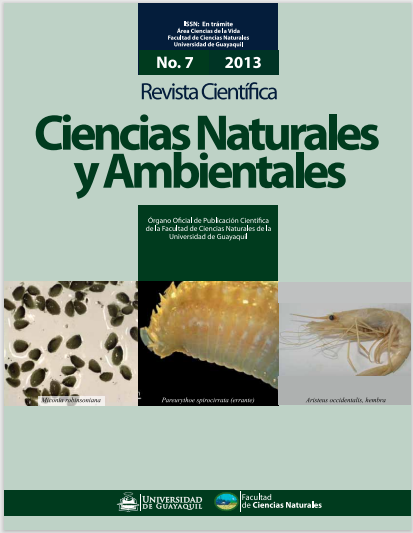Los crustáceos decápodos de aguas profundas del mar ecuatoriano
DOI:
https://doi.org/10.53591/cna.v7i1.205Palabras clave:
Dendrobranchiata, Pleocyemata, Talud continental,, distribución vertical y horizontalResumen
Se analizaron 63 muestras de crustáceos decápodos, colectados entre las latitudes 1º18’N y 3º12’S, en el talud continental, entre 500 a 1500 metros de profundidad. Identificándose 44 especies ubicadas así: del Suborden Dendrobranchiata, Superfamilia Penaeoidea 4, del Suborden Pleocyemata están los infraórdenes: Caridea con 18 especies, Astacidea 1, Palinura 3, Anomura 11 y de Brachyura 7. Se elaboró una clave para las familias encontradas; así como, para las especies identificadas. El análisis de los resultados en relación al aspecto zoogeográficos encontramos: 5 especies de la subprovincia de Galápagos presentes en el talud continental como: Aristeus occidentalis, Munida hispida, Lithodes galapagensis, Rochinia cornuta y Tricopeltarium corallinus; dos especies consideradas restringidas para la provincia Perú Chile como Glyphus marsupialis y Neolithodes diomedeae que amplían su distribución al Golfo de Guayaquil. En relación a las especies de alto potencial económico se encuentran los camarones: Haliporoides diomedeae, Nematocarcinus agassizii, Benthesicymus tanneri y Heterocarpus hostilis, otro de los grupos importantes tanto desde el punto vista alimenticio como económico son los cangrejos litodides como Neolithodes diomedeae, Paralomis papillata y Paralomis otsuae que soportan una pesquería en los países del cono sur. Debido a estos aspectos se recomienda que se continué con este tipo de estudio para conocer nuestra fauna, realizar estudio biológico de las especies para saber si pueden soportar una extracción sin afectar a las poblaciones que por siglos se encuentra en esta área.
Citas
Abele L.G & B. E. Felgenhauer 1982. Decapoda en:
S.P. Parker, ed., Synopsis and Classification of living
organisms, vol. 2., pp:296-326. McGraw-Hill Book
Company, New York.
Abele L.G. & W. Kim 1986. An illustrated guide to
the marine decapod crustaceans of Florida. Dept.
Environm. Regul. Tech. Series. 8(1):i-xviii. 1-326.
Ahyong S. T y B. S. Galil. 2006. Polychelidae from
the southern and western Pacific (Decapoda,
Polychelidae). ZOOSYSTEMA. 28(3).
www.zoosystema.com
Baba K. 1977. Gastroptychus cavimurus sp. nov., a
new Chirostylid (Crustacea, Decapoda, Anomura)
from of the western coast of South America.
Zoologische Mededelingen., Leiden 52 (16): 201-207,
figs. 1-3
Barría E. M. & C. G. Jara, 2005. Nuevo registro de
Paralomis otsuae Wilson, 1990 (Decapoda, Anomura,
Lithodidae) en la costa centro - sur de Chile. Inves.
Mar. Valparaíso, 33 (1): 115-120.
Bate, C.S. 1888. Report on the Crustacea Macrura
collected by HMS Challenger during the years 1873-
Challenger Rept. Zool. 24: 1 - 942
Brito J. L. 2002. Lithodidae registrados frente a
San Antonio, Chile central (Crustáceo, Anomura).
Investigaciones Marinas, versión On-.line ISSN 0717-
Borradaile, L. A., 1907. On the classification of the
decapod crustaceans. Annal and Magazine of Natural
History, (7)19:457-486.
Boschi EE. 2000. Species of Decapod Crustaceans
and Their Distribution in the American Marine
Zoogeographic Provinces. Rev. Invest. Des. Pesq. Nº
: 7-136.
Bowman, T.E. & L.G. Abele. 1982. Classification of
the recent Crustacea. Biol. Crust. In: L. G. Abele (ed)
The Biology of Crustacea. Vol. 1: Systematics, the
Fossil record, and Biogeography. Academy Press,
New York, USA. 1-27
Burkenroad, M. D. 1963. The evolution of
the Eucarida (Crustacea Eumalacostraca), in relation to the fossil record. Tulane Studies in
Geology. 2 (1):1-17.
Burkenroad, M. D., 1981. The higher taxonomy
and evolution of Decapoda (Crustacea).
Transactions of the San Diego Natural History
Society, 19 (17):251- 268.
Calman, R. T., 1909. Crustacea. En: R. Lankester
(ed). A Treatise on Zoology. Vol. VII. Adams &
Charles Black, London.
Cárdenas González E. De, y M. Paz Maroto
Castaño .2009. Informe de Investigación Pesquera
Campaña Ecuador 2008, B/O Miguel Oliver pp:
Subsecretaría de Pesca.
Cañón J. R. 1976. Resultados de arrastres
exploratorios de profundidad efectuados en el B/I
―Eastward‖ en el Golfo de Guayaquil durante el mes
de Noviembre de1976. Serie Informes Pesqueros
Nº07/76 Inst. Nacional de Pesca. Ecuador.
Castro P. 2005. Crabs of the subfamily Ethusinae
Guinot, 1977 (Crustacea, Decapoda, Brachyura,
Dorippidae) of the Indo-West Pacific region.
ZOOSYSTEMA. 27 (3).
/05/2009]
Chace, F. A. 1986. The caridean shrimps (Crustacea:
Decapoda) of the ―Albatross‖ Phillipine Expedition,
- 1910, Part.4; Families Oplophoridae and
Nematocarcinidae, Smithson. Contr. Zool. 432:1-82.
Faxon, W.1893. Reports on the dredging operations
off the west coast of Central America to the
Galapagos, to the west coast of Mexico, and the Gulf
of California, in charge of Alexander Agassiz, carried
on by the U.S. Fish Commission ―Albatross‖, during
,, Lieut. Commander Z.L. Tanner, U,S.N.,
commanding. VI. Preliminary descriptions of the new
species of Crustacea. Bull. Mus. Com. Zool. Harvard.
:140-220.
Faxon W. 1895. Reports on an exploration off the
west coast of Mexico, Central and South America, and
the Galapagos Islands, in charge of Alexander
Agassiz, by the U.S. Fish Commission steamer
―Albatross‖, during 1891, Lieut. Commander Z.L.
Tanner, USN., commanding XV. The stalk-eyed
Crustacea. Mem. Mus. Comp. Zool. Harvard, 18:1-
Felgenhauer B. & L. Abele. 1983. Phylogenetic
Relationship among Shrimp-like decapods., en:
Schram, F. R. (ed)Crustacean Phylogeny, Crustacean
Issues. Schram, F.R. (series ed). Vol 1.
Rotterdam: A.A. Balkema: 291-311pp.
<http://decapoda.nhm.org./references/newpdfs.html?p
agescale=normal> [11/03/2009]
Glaessner, M.F., 1969. Decapoda. En: R.C.Moore
(ed). Treatise on invertebrate Paleontology.
Arthropoda 4. Part R. Vol.2: R399-533. Lawrence:
Geol. Soc. Am & Univ. Kansas Press.
González K. 2000. Revisión Histórica de las
Investigaciones de los Crustáceos Decápodos en la Zona Costera del Ecuador. CEBIMAR Subsecretaría
del Medio Ambiente
Guzmán G. L, 2004. Oplophoridae (Decapoda,
Caridea) in Southern Pacific Ocean, revision of
Chilean Species. Gayana 68 (1); 70-75. Version On –
line ISSN 0717-6538
Guzmán,G., P. Báez & J, Sellanes, 2009. Primer
registro de Trichopeltarium corallinus (Faxon, 1893)
para el mar de Chile y nuevo registro de T. hystricosus
(Garth, en Garth & Haig, 1971) (Decapoda:
Brachyura: Atelecyclidae). Lat. Am.J. Aquat. Res.,37
(2): 275-279.
Haig J., T. Hopkins & T. Scandland. 1970. The
Shallow Water Anomuran Crab Fauna of
Southwestern Baja California, Mexico. San Diego
Soc. Nat. Hist. Trans. 16 (2): 13-32
Haig J. 1955. The Crustacea Anomura of Chile.
Reports of The Lund University Chile Expedition
-49. Contribution Nº 158.,pp: 1-68 From the
Allan Hancock Foundation.
Revuelta A. G., & V. H. Andrade. 1978. Nueva
localidades para Lithodes murrayi Henderson en el
Pacifico Sud Oriental (Crustacea, Decapoda,
Anomura, Lithodidae). Nat. Mens. Mus. Nac. Hist.
Nat. (Chile). 22: 3-4.
Wicksten M. K. 2008. Decapod Crustacea of the
Californian and Oregonian Zoogeographic
Provinces.
<http://repositories.edlib.org/sio/lib/26/> [Mayo
/6/2009]
Williams, A.B, 1984. Shrimps, lobsters, and crabs of
the Atlantic coast. Smithsonian Institution Press,
Washington, D.C.,U.S.A., 550pp.
Descargas
Publicado
Cómo citar
Número
Sección
Licencia
Derechos de autor 2021 Matilde Cornejo Antepara

Esta obra está bajo una licencia internacional Creative Commons Atribución-NoComercial-CompartirIgual 4.0.














